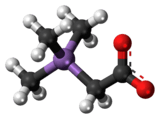Arsenobetaine
 | |
 | |
| Names | |
|---|---|
| Preferred IUPAC name
2-Trimethylarsoniumylacetate | |
| Systematic IUPAC name
2-(Trimethylarsaniumyl)acetate | |
| Identifiers | |
| 3933180 | |
| 64436-13-1 | |
| ChemSpider | 43109 |
| |
| Jmol-3D images | Image Image |
| KEGG | C19331 |
| MeSH | Arsenobetaine |
| PubChem | 47364 |
| RTECS number | CH9750000 |
| |
| Properties | |
| Molecular formula |
C5H11AsO2 |
| Molar mass | 178.06 g·mol−1 |
| Hazards | |
| EU classification | Toxic (T); Dangerous for the environment (N) |
| R-phrases | R23/25 R50/53 |
| S-phrases | S20/21 S28 S45 S60 S61 |
| Except where noted otherwise, data is given for materials in their standard state (at 25 °C (77 °F), 100 kPa) | |
| | |
| Infobox references | |
Arsenobetaine is an organoarsenic compound that is the main source of arsenic found in fish.[1][2][3][4] It is the arsenic analog of trimethylglycine, commonly known as betaine. The biochemistry and its biosynthesis are similar to those of choline and betaine.
Arsenobetaine is a common substance in marine biological systems and unlike many other organoarsenic compounds, such as dimethylarsine and trimethylarsine, it is relatively non-toxic.[5]
It has been known since 1920 that marine fish contain organoarsenic compounds, but it was not until 1977 that the chemical structure of the most predominant compound arsenobetaine was determined.[6]
References
- ↑ Maher, B. (2005). "Foreword: Research Front — Arsenic Biogeochemistry". Environmental Chemistry 2 (3): 139–140. doi:10.1071/EN05063.
- ↑ Francesconi, K. A. (2005). "Current Perspectives in Arsenic Environmental and Biological Research". Environmental Chemistry 2 (3): 141–145. doi:10.1071/EN05042.
- ↑ Adair, B. M.; Waters, S. B.; Devesa, V.; Drobna, Z.; Styblo, M.; Thomas, D. J. (2005). "Commonalities in Metabolism of Arsenicals". Environmental Chemistry 2 (3): 161–166. doi:10.1071/EN05054.
- ↑ Ng, J. C. (2005). "Environmental Contamination of Arsenic and its Toxicological Impact on Humans". Environmental Chemistry 2 (3): 146–160. doi:10.1071/EN05062.
- ↑ Bhattacharya, P.; Welch, A. H.; Stollenwerk, K. G.; McLaughlin, M. J.; Bundschuh, J.; Panaullah, G. (2007). "Arsenic in the Environment: Biology and Chemistry". Science of the Total Environment 379 (2–3): 109–120. doi:10.1016/j.scitotenv.2007.02.037. PMID 17434206.
- ↑ Edmonds, J. S.; Francesconi, K. A.; Cannon, J. R.; Raston, C. L.; Skelton, B. W.; White, A. H. (1977). "Isolation, Crystal Structure and Synthesis of Arsenobetaine, the Arsenical Constituent of the Western Rock Lobster Panulirus longipes cygnus George". Tetrahedron Letters 18 (18): 1543–1546. doi:10.1016/S0040-4039(01)93098-9.
Further reading
- Craig, P. J. (2003). Organometallic Compounds in the Environment (2nd ed.). Chichester: John Wiley and Sons. p. 415. ISBN 978-0-471-89993-8.